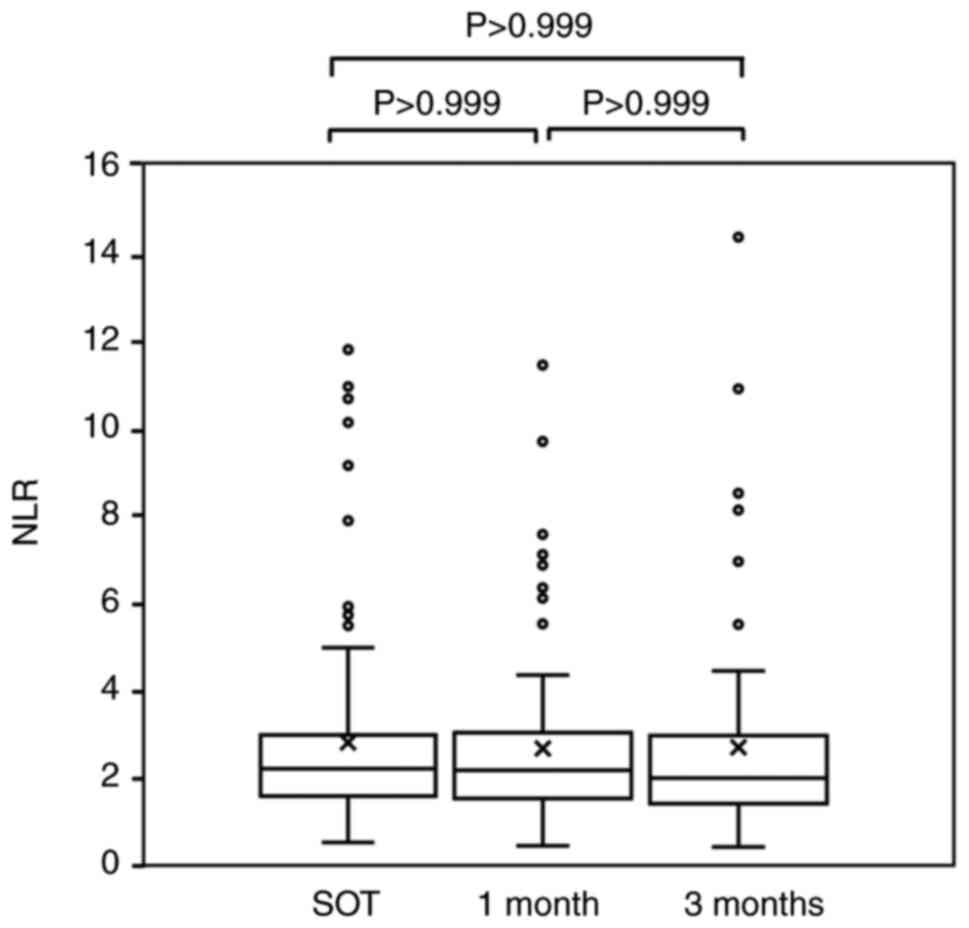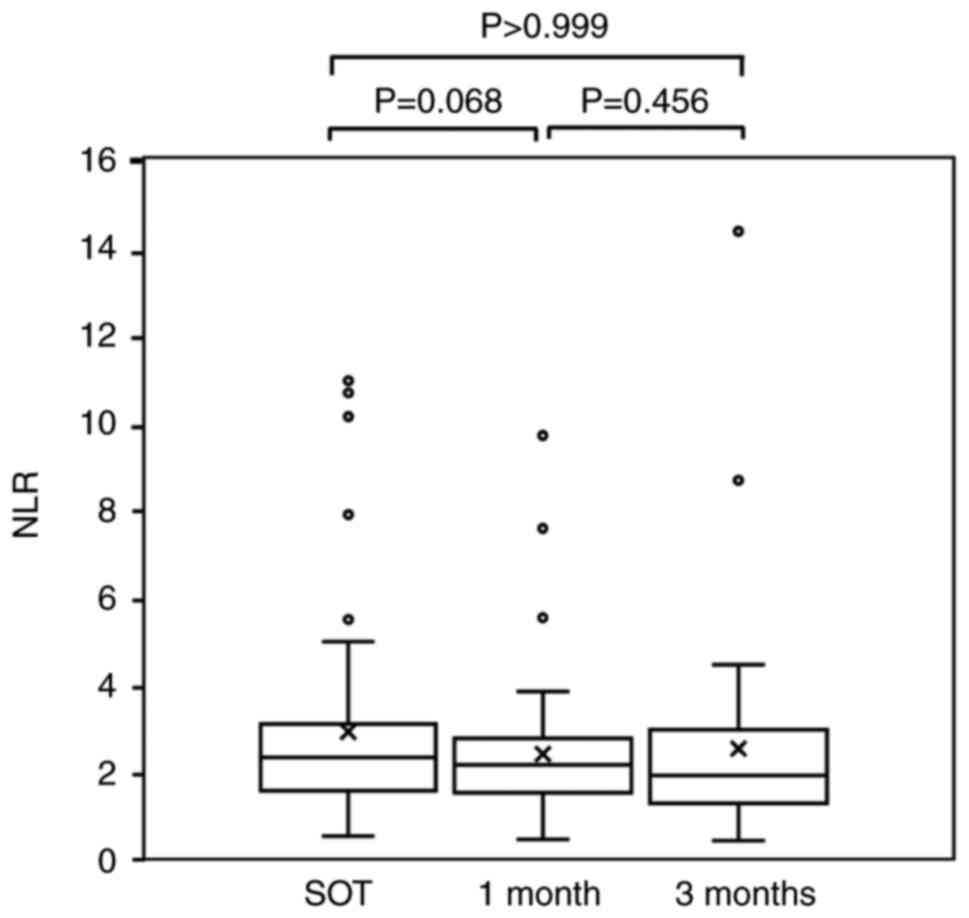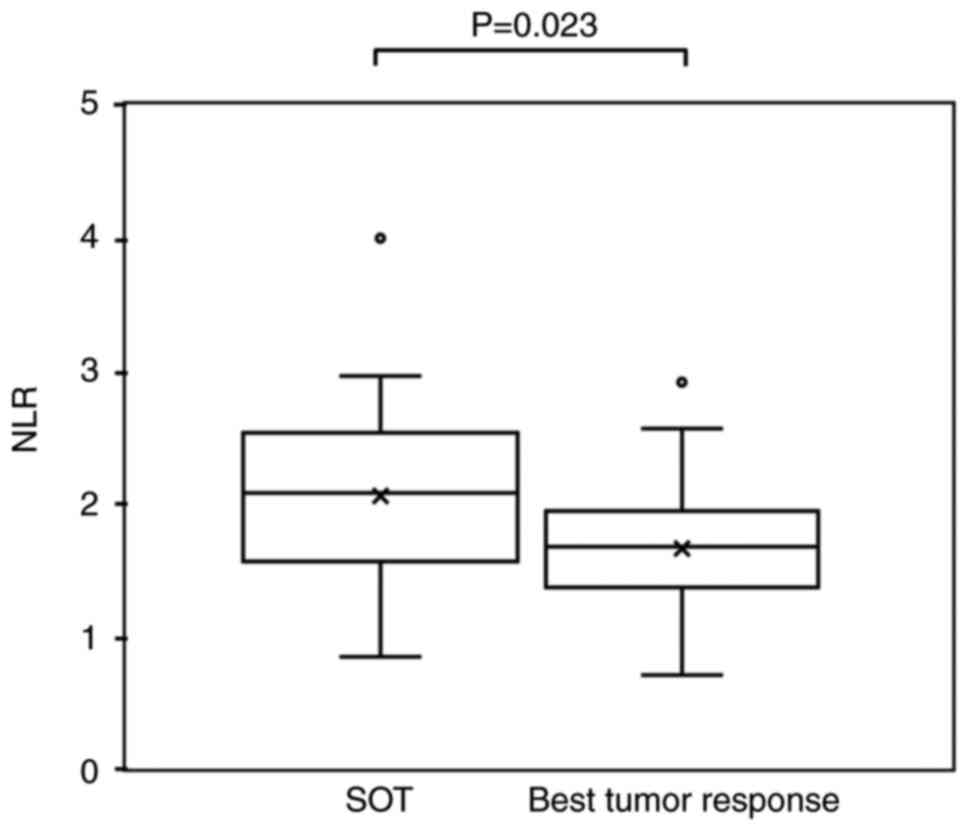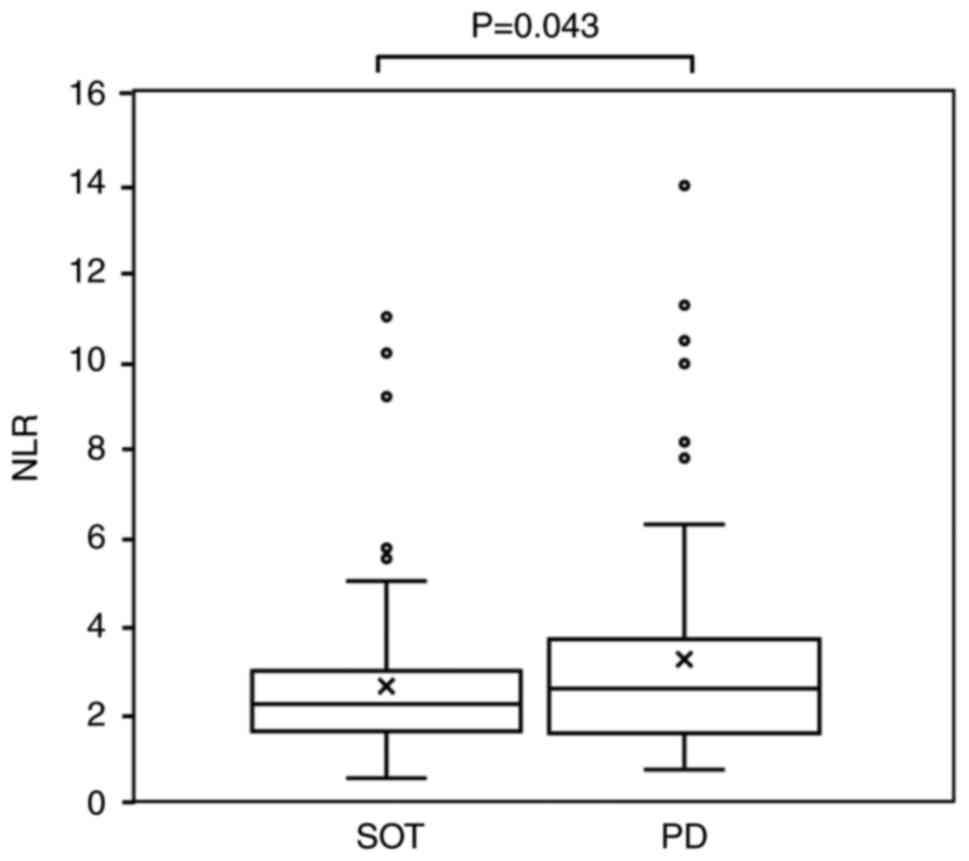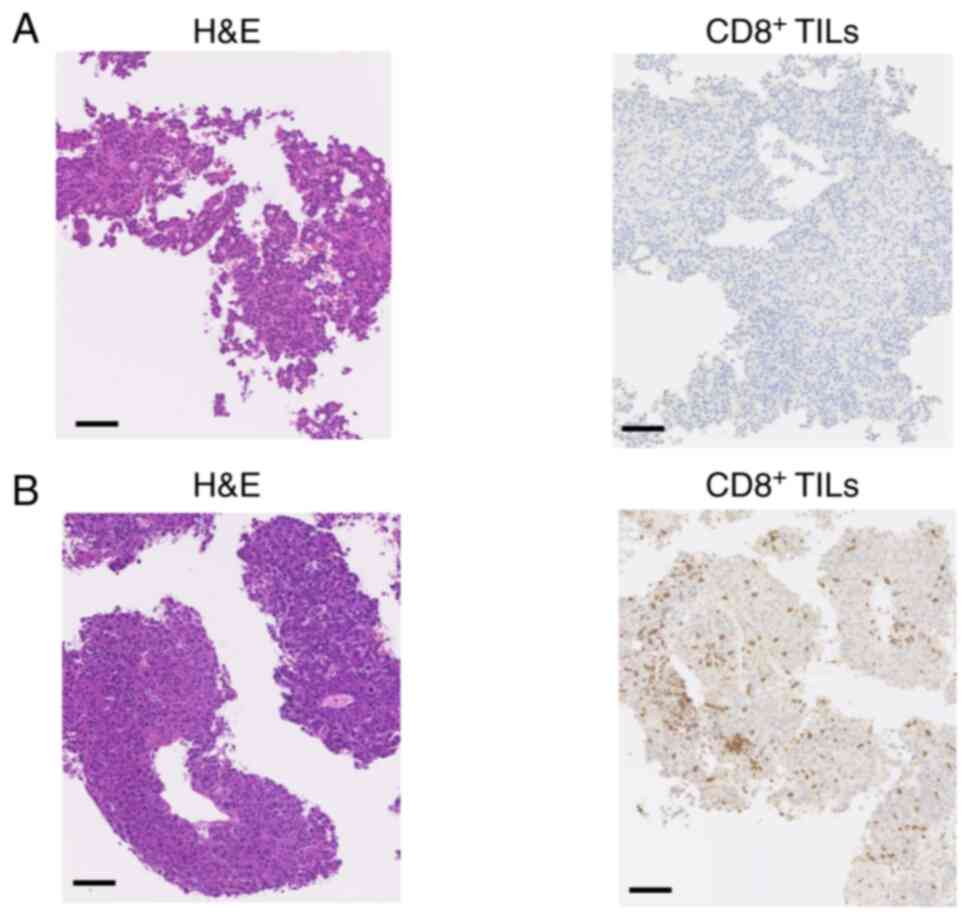Dynamics of the neutrophil‑to‑lymphocyte ratio during lenvatinib treatment for unresectable hepatocellular carcinoma
- Authors:
- Published online on: May 10, 2024 https://doi.org/10.3892/ol.2024.14442
- Article Number: 309
-
Copyright: © Kuwano et al. This is an open access article distributed under the terms of Creative Commons Attribution License.
Abstract
Introduction
With an estimated 900,000 new cases and 830,000 associated deaths in 2020, hepatocellular carcinoma (HCC) ranks as the sixth most common neoplasm and the third leading cause of cancer-related mortality worldwide (1,2). Recent advancements in systemic chemotherapy for advanced HCC, including immune checkpoint inhibitors (ICIs) and molecular targeted agents, have enhanced patient outcomes (3–8). The main elements of the tumor immune microenvironment (TIME) include cancer cells, antigen, immune cells and cytokines. These components interact with each other to determine the tendency of antitumor immunity (9). ICIs exhibit antitumor effects by reactivating the immune cells in TIME and it is imperative to elucidate the TIME in HCC.
Lenvatinib, an oral multi-kinase inhibitor targeting vascular endothelial growth factor receptors 1–3, fibroblast growth factor receptors 1–4, platelet-derived growth factor receptor α, rearranged during transfection and stem cell factor receptor, has demonstrated anticancer efficacy (10). A global, randomized, multicenter, open-label trial assessing the non-inferiority of lenvatinib compared with sorafenib (REFLECT; NCT01761266) revealed that lenvatinib significantly improved progression-free survival (PFS) versus sorafenib in patients with previously untreated, metastatic or advanced HCC (3). Lenvatinib is currently approved for the treatment of HCC. Recently, Yamauchi et al (11) described the capability of lenvatinib to modulate the TIME in HCC.
Inflammation has an important role in cancer, and neutrophils suppress T cell function by secreting myeloperoxidase and arginase-1, and upregulating programmed cell death ligand 1 (12). Therefore, neutrophils create an immunosuppressive tumor microenvironment that reduces the efficacy of immunotherapy (13). Lymphocytes also have a role in cytotoxic cell death, and they produce cytokines to inhibit tumor cell growth (14). The neutrophil-to-lymphocyte ratio (NLR) is considered a systemic marker of the balance between adaptive immune surveillance and the inflammatory status. A high NLR at baseline is associated with a poor prognosis in numerous types of cancer, such as lung, thyroid, biliary tract and colon cancer, and the dynamics of the NLR are associated with prognosis or treatment efficacy in various cancer types, such as lung cancer, renal cell carcinoma and gastrointestinal cancer, treated with systemic chemotherapies such as ICIs (15–22). It has been reported that the dynamics of the NLR reflect changes in the TIME and capture antitumor immune responses, ultimately being associated with clinical outcomes following immune checkpoint blockade (23). To the best of our knowledge, to date, no reports have evaluated the dynamics of the NLR as a biomarker of the TIME during lenvatinib therapy in HCC. The present study therefore investigated the dynamics of the NLR in this context.
Patients and methods
Patients
The current prospective, single-center study analyzed the dynamics of the NLR in patients with HCC who were treated with lenvatinib at Aso Iizuka Hospital (Iizuka, Japan) between May 2018 and February 2023. In total, 130 patients with unresectable HCC who received lenvatinib treatment as first-line treatment or post-progression treatment after other therapies, including transarterial chemoembolization, sorafenib, and atezolizumab plus bevacizumab, were identified. Finally, 101 patients were evaluated, after excluding 29 patients who were observed for <12 weeks and did not have images to assess treatment efficacy. Additionally, liver tumor biopsy samples were obtained with consent from 9 patients treatment to assess the TIME prior to subsequent chemotherapy treatment for progression or discontinuation due to adverse events on lenvatinib treatment. This study adhered to the Declaration of Helsinki guidelines and received approval from the Iizuka Hospital Ethics Committee (approval no. 18070). All patients provided written informed consent. Specific written informed consent was obtained from 2 patients for the publication of their immunohistochemistry results.
Biomarker analysis
Peripheral blood (2 ml) was obtained from the patients at the start of treatment and at each hospital visit during lenvatinib treatment. The NLR was a calculation based on the absolute neutrophil count divided by the absolute lymphocyte count determined by complete blood count differential in the peripheral blood.
Treatment protocol
Patients received oral lenvatinib (Eisai Co., Ltd.) based on body weight (8 mg/day for those weighing <60 kg and 12 mg/day for those weighing ≥60 kg). Reduction of the initial dose was permitted according to the performance status (by assessment of the level of function and capability of self-care) and the presence of proteinuria at the start of treatment (SOT) (4–8 mg/day). Dose adjustment, including interruption and reduction (to 8 mg/day, 4 mg/day or 4 mg every other day), was permitted during treatment according to the performance status and adverse events. The protocols outlined in the REFLECT trial, as prescribed by Eisai Co., Ltd., were followed (3). Adverse events were graded using the Common Terminology Criteria for Adverse Events, version 4.0 (24). Grade 3 or higher adverse events or any unacceptable grade 2 events led to a reduction in the drug dose or interrupted treatment according to the lenvatinib administration guidelines. Following the occurrence of an adverse event, the lenvatinib dose was reduced or treatment was temporarily halted until symptoms improved to grade 1 or 2, in line with Eisai Co., Ltd., guidelines.
Evaluation of efficacy
The treatment response was assessed every 8–12 weeks after treatment initiation using computed tomography or magnetic resonance imaging. The antitumor response was evaluated by the treating physician based on the modified Response Evaluation Criteria in Solid Tumours version 1.1 (25). The disease control rate (DCR) was defined as the sum of the rates for complete response (CR), partial response (PR) and stable disease lasting at least 4 months. The objective response rate (ORR; also referred to as the best response) was defined as the sum of the PR and CR rates. Patients were followed up every 4 weeks, and long-term treatment was continued until disease progression or intolerable side effects occurred.
Immunohistochemistry (IHC)
Liver tumor biopsy specimens were fixed in 10% formalin at room temperature for 10–48 h and embedded in paraffin. Serial sections (5 µm) were cut from the paraffin blocks and stained with hematoxylin and eosin (hematoxylin for 3 min and eosin for 45 sec at room temperature). CD8+ T-cell staining was performed with a Leica Bond-III, which is an automatic and continuous access slide-staining system that simultaneously processes IHC protocols, using a Bond Polymer Refine Detection Kit (Leica Biosystems). Specimens were then incubated for 30 min with the primary antibody mouse anti-human monoclonal CD8 antibody (clone C8/144B; 1:50; Dako; Agilent Technologies, Inc.), followed by visualization with the Leica Bond Polymer Refine Detection kit for 20 min at room temperature. The sections were counterstained with hematoxylin, dehydrated and mounted. The slides were examined under the BZ-X700 fluorescence microscope (Keyence Corporation). CD8+ cell infiltration was quantified according to the number of positively stained CD8+ tumor-infiltrating lymphocytes (TILs) at ×400 magnification, focusing on areas with the densest CD8+ TIL presence. A cutoff of 15.9 cells/high-power field was utilized to classify high and low CD8+ TIL infiltration, consistent with a previous report (26).
Statistical analysis
JMP Pro version 11 (SAS Institute Inc.) was utilized for all statistical analyses. Data are presented as the median (interquartile range) or mean (standard deviation). The Kaplan-Meier method was applied for statistical testing to evaluate overall survival (OS) time, PFS time and first objective response time. NLR was compared at different time points using Friedman's test with Dunn's post hoc test or a paired t-test. P<0.05 was used to indicate a statistically significant difference.
Results
Patient characteristics
The characteristics of the 101 patients who received lenvatinib are presented in Table I. A total of 54 patients (53.5%) required a reduction of the initial dose of lenvatinib. The ORR was 25.7% (26/101 patients) and the DCR was 58.4% (59/101 patients). The median PFS time was 6.0 months [95% confidence interval (CI), 4.9–7.5] and the median OS time was 27.9 months (95% CI, 16.5–32.8). Median time to first objective response was 3.1 months (95% CI, 2.3–3.6 months).
Dynamics of the NLR after treatment with lenvatinib
The NLR values at the SOT, after 1 month of treatment and after 3 months of treatment were 2.78±2.20, 2.61±1.86 and 2.66±2.36, respectively (P=0.733; Friedman's test) (Fig. 1). Among the patients with no reduction of the initial dose, the NLR values at the SOT, after 1 month of treatment and after 3 months of treatment were 2.86±2.33, 2.34±0.25 and 2.48±2.26 (P=0.613; Friedman's test) (Fig. 2). There was no significant difference between the NLR after 1 month and that at the SOT. Among the patients with an objective response, the NLR at the time of the best tumor response was 1.65±0.56, which was significantly lower than that at the SOT (2.05±0.78) (P=0.023; Fig. 3). Among the non-responders, the NLR was significantly higher at the time of disease progression (3.68±3.19) compared with that at the SOT (2.78±1.79) (P=0.043; Fig. 4).
IHC for CD8+ TILs in HCC tissues
CD8+ TIL counts were assessed by IHC after lenvatinib treatment and prior to subsequent-line chemotherapy in 9 patients (Table II). In total, 5 out of 6 patients who did not respond to lenvatinib had low CD8+ TIL counts at disease progression. A typical case is presented in Fig. 5A (case 6). Furthermore, 2 out of the 3 patients who discontinued treatment due to adverse events had high CD8+ TIL counts. A typical case is presented in Fig. 5B (case 7).
Discussion
The immune response serves a crucial role in the progression of cancer. The most recent immunogenomic classification of HCC was published in 2022 (27). This study reported that ICI treatment was likely to initiate a response in 65% of HCC cases in the non-inflammatory group and in 35% of cases in the inflammatory group. The inflammatory group was characterized by robust interferon signaling and cytolytic activity, upregulated effector molecules of cytotoxic T cells, and increased checkpoint molecule levels and CD8+ T-cell counts. HCC is influenced by the TIME, which has been reported to benefit from immune checkpoint blockade treatment (28).
Clinical trials and preclinical studies investigating the immunomodulatory effects of antiangiogenic agents on the tumor microenvironment have highlighted enhanced maturation of dendritic cells, improved trafficking and function of T cells, and reversal of immunosuppression that is induced by hypoxia or immunosuppressive cells (29–31). Further in vivo and in vitro studies have illustrated that molecular targeted agents enhance antitumor immunity by promoting the polarization of tumor-associated macrophages to an M1 phenotype (32–34), enhancing the infiltration and functions of CD4+ and CD8+ T cells (35,36), reducing the numbers of regulatory T cells (37–39), and reversing the suppressive functions of myeloid-derived suppressor cells in the tumor microenvironment (40,41). Lenvatinib has also been demonstrated to modulate the TIME (11,42–44). It is important to evaluate the TIME in the treatment of HCC. However, previous studies have required liver tumor biopsy tissues to be obtained, highlighting the need for a non-invasive biomarker for predicting treatment response.
The NLR is a simple and inexpensive measure of the balance between adaptive immune surveillance and the inflammatory status (16). Tada et al (45) reported that a high NLR was associated with negative outcomes (PFS, ORR, and DCR) in patients who received lenvatinib for HCC. However, the dynamics of the NLR in patients with unresectable HCC treated with lenvatinib have not been thoroughly investigated.
In the present study, the NLR decreased at the time of the best tumor response among the patients with an objective response, indicating an inflammatory condition, whereas NLR elevation at the time of disease progression suggested a non-inflammatory condition. There was notably less CD8+ TIL infiltration in liver tumor tissue at the time of disease progression in patients who did not respond to lenvatinib. The results suggest that NLR may be useful for assessing the TIME and treatment efficacy.
Recently, the combination of an ICI and a vascular endothelial growth factor inhibitor (atezolizumab plus bevacizumab) and the combination of the ICIs tremelimumab and durvalumab were approved as systemic therapy options for patients with advanced HCC (4,8). If the tumor is inflamed prior to ICI treatment, the response to ICI treatment might be improved. Therefore, switching to ICI treatment early or before disease progression after lenvatinib administration could improve prognosis.
The limitations of the present study include included the small number of patients due to the single-center design and the lack of observation of tumor tissue over time. The NLR can be influenced by numerous factors, including age, body mass index, steroidal drugs, viral hepatitis, alcoholic fatty liver and diabetes (46,47). The present study encompassed advanced HCC cases with varying stages and levels of liver function. Matching patients according to these factors is not feasible when analyzing a small case series. These factors warrant consideration, and randomized controlled trials should be conducted in future. Nevertheless, despite the limitations of the present study, NLR dynamics may be recognized in future as a useful marker of the TIME.
In conclusion, the NLR at the time of the best tumor response was lower than that at the SOT among the patients with a PR or CR. Among the non-responders, the NLR was higher at the time of disease progression than at the SOT. These findings suggest the potential of lenvatinib as an immunomodulator. Further studies exploring the impact of different treatment methods on the TIME of HCC and further studies with larger sample sizes are required to investigate the TIME in patients with advanced HCC.
Acknowledgements
The authors are grateful to Ms. Yukie Ishibashi (Department of Hepatology, Iizuka Hospital, Iizuka, Japan) for assistance with manuscript preparation.
Funding
Funding: No funding was received.
Availability of data and materials
The data generated in the present study may be requested from the corresponding author.
Authors' contributions
AK, MY, AM and KM designed the study. AK, YK and KT assisted with data analyses. YO performed pathological examinations, including immunostaining. AK wrote the initial draft of the manuscript. MY contributed to data analysis and interpretation. MY, AM and KM assisted in the preparation and critical review of the manuscript. AK and MY confirm the authenticity of all the raw data. All authors read and approved the final version of the manuscript and agree to be accountable for all aspects of the work.
Ethics approval and consent to participate
The study was performed in accordance with the principles and ethical guidelines of the 1975 Declaration of Helsinki. The study received approval from the Aso Iizuka Hospital Ethics Committee (Iizuka, Japan; approval no. 18070). All patients provided written informed consent.
Patient consent for publication
Written informed consent was obtained from two patients for the publication of their immunohistochemistry results.
Competing interests
The authors declare that they have no competing interests.
Glossary
Abbreviations
Abbreviations:
|
HCC |
hepatocellular carcinoma |
|
ICI |
immune checkpoint inhibitor |
|
TIME |
tumor immune microenvironment |
|
PFS |
progression-free survival |
|
NLR |
neutrophil-to-lymphocyte ratio |
|
CR |
complete response |
|
PR |
partial response |
|
DCR |
disease control rate |
|
ORR |
objective response rate |
|
IHC |
immunohistochemistry |
|
TIL |
tumor-infiltrating lymphocyte |
|
CI |
confidence interval |
|
SOT |
start of treatment |
References
|
Caldwell S and Park SH: The epidemiology of hepatocellular cancer: From the perspectives of public health problem to tumor biology. J Gastroenterol. 44:96–101. 2009. View Article : Google Scholar : PubMed/NCBI | |
|
Sung H, Ferlay J, Siegel RL, Laversanne M, Soerjomataram I, Jemal A and Bray F: Global cancer statistics 2020: GLOBOCAN estimates of incidence and mortality worldwide for 36 cancers in 185 countries. CA Cancer J Clin. 71:209–249. 2021. View Article : Google Scholar : PubMed/NCBI | |
|
Kudo M, Finn RS, Qin S, Han KH, Ikeda K, Piscaglia F, Baron A, Park JW, Han G, Jassem J, et al: Lenvatinib versus sorafenib in first-line treatment of patients with unresectable hepatocellular carcinoma: A randomised phase 3 non-inferiority trial. Lancet. 391:1163–1173. 2018. View Article : Google Scholar : PubMed/NCBI | |
|
Finn RS, Qin S, Ikeda M, Galle PR, Ducreux M, Kim TY, Kudo M, Breder V, Merle P, Kaseb AO, et al: Atezolizumab plus Bevacizumab in unresectable hepatocellular carcinoma. N Engl J Med. 382:1894–1905. 2020. View Article : Google Scholar : PubMed/NCBI | |
|
El-Khoueiry AB, Sangro B, Yau T, Crocenzi TS, Kudo M, Hsu C, Kim TY, Choo SP, Trojan J, Welling TH Rd, et al: Nivolumab in patients with advanced hepatocellular carcinoma (CheckMate 040): An open-label, non-comparative, phase 1/2 dose escalation and expansion trial. Lancet. 389:2492–2502. 2017. View Article : Google Scholar : PubMed/NCBI | |
|
Zhu AX, Finn RS, Edeline J, Cattan S, Ogasawara S, Palmer D, Verslype C, Zagonel V, Fartoux L, Vogel A, et al: Pembrolizumab in patients with advanced hepatocellular carcinoma previously treated with sorafenib (KEYNOTE-224): A non-randomised, open-label phase 2 trial. Lancet Oncol. 19:940–952. 2018. View Article : Google Scholar : PubMed/NCBI | |
|
Becht R, Kiełbowski K and Wasilewicz MP: New opportunities in the systemic treatment of hepatocellular carcinoma-today and tomorrow. Int J Mol Sci. 25:14562024. View Article : Google Scholar : PubMed/NCBI | |
|
Abou-Alfa GK, Lau G, Kudo M, Chan SL, Kelley RK, Furuse J, Sukeepaisarnjaroen W, Kang YK, Van Dao T, De Toni EN, et al: Tremelimumab plus Durvalumab in unresectable hepatocellular carcinoma. NEJM Evid. 1:EVIDoa21000702022. View Article : Google Scholar : PubMed/NCBI | |
|
Locy H, de Mey S, de Mey W, De Ridder M, Thielemans K and Maenhout SK: Immunomodulation of the tumor microenvironment: Turn foe into friend. Front Immunol. 9:29092018. View Article : Google Scholar : PubMed/NCBI | |
|
Cabanillas ME and Habra MA: Lenvatinib: Role in thyroid cancer and other solid tumors. Cancer Treat Rev. 42:47–55. 2016. View Article : Google Scholar : PubMed/NCBI | |
|
Yamauchi M, Ono A, Amioka K, Fujii Y, Nakahara H, Teraoka Y, Uchikawa S, Fujino H, Nakahara T, Murakami E, et al: Lenvatinib activates anti-tumor immunity by suppressing immunoinhibitory infiltrates in the tumor microenvironment of advanced hepatocellular carcinoma. Commun Med (Lond). 3:1522023. View Article : Google Scholar : PubMed/NCBI | |
|
Oberg HH, Wesch D, Kalyan S and Kabelitz D: Regulatory interactions between neutrophils, tumor cells and T cells. Front Immunol. 10:16902019. View Article : Google Scholar : PubMed/NCBI | |
|
Valero C, Lee M, Hoen D, Weiss K, Kelly DW, Adusumilli PS, Paik PK, Plitas G, Ladanyi M, Postow MA, et al: Pretreatment neutrophil-to-lymphocyte ratio and mutational burden as biomarkers of tumor response to immune checkpoint inhibitors. Nat Commun. 12:7292021. View Article : Google Scholar : PubMed/NCBI | |
|
Ding PR, An X, Zhang RX, Fang YJ, Li LR, Chen G, Wu XJ, Lu ZH, Lin JZ, Kong LH, et al: Elevated preoperative neutrophil to lymphocyte ratio predicts risk of recurrence following curative resection for stage IIA colon cancer. Int J Colorectal Dis. 25:1427–1433. 2010. View Article : Google Scholar : PubMed/NCBI | |
|
Xu N, Jian Y, Wang Y and Tian W: Evaluation of neutrophil-to-lymphocyte ratio and calcitonin concentration for predicting lymph node metastasis and distant metastasis in patients with medullary thyroid cancer. Mol Clin Oncol. 6:629–634. 2018.PubMed/NCBI | |
|
Templeton AJ, McNamara MG, Šeruga B, Vera-Badillo FE, Aneja P, Ocaña A, Leibowitz-Amit R, Sonpavde G, Knox JJ, Tran B, et al: Prognostic role of neutrophil-to-lymphocyte ratio in solid tumors: A systematic review and meta-analysis. J Natl Cancer Inst. 106:dju1242014. View Article : Google Scholar : PubMed/NCBI | |
|
Moschetta M, Uccello M, Kasenda B, Mak G, McClelland A, Boussios S, Forster M and Arkenau HT: Dynamics of neutrophils-to-lymphocyte ratio predict outcomes of PD-1/PD-L1 blockade. Biomed Res Int. 2017:15068242017. View Article : Google Scholar : PubMed/NCBI | |
|
Cho KM, Park H, Oh DY, Kim TY, Lee KH, Han SW, Im SA, Kim TY and Bang YJ: Neutrophil-to-lymphocyte ratio, platelet-to-lymphocyte ratio, and their dynamic changes during chemotherapy is useful to predict a more accurate prognosis of advanced biliary tract cancer. Oncotarget. 8:2329–2341. 2017. View Article : Google Scholar : PubMed/NCBI | |
|
Soda H, Ogawara D, Fukuda Y, Tomono H, Okuno D, Koga S, Taniguchi H, Yoshida M, Harada T, Umemura A, et al: Dynamics of blood neutrophil-related indices during nivolumab treatment may be associated with response to salvage chemotherapy for non-small cell lung cancer: A hypothesis-generating study. Thorac Cancer. 10:341–346. 2019. View Article : Google Scholar : PubMed/NCBI | |
|
Xie X, Liu J, Yang H, Chen H, Zhou S, Lin H, Liao Z, Ding Y, Ling L and Wang X: Prognostic value of baseline neutrophil-to-lymphocyte ratio in outcome of immune checkpoint inhibitors. Cancer Invest. 37:265–274. 2019. View Article : Google Scholar : PubMed/NCBI | |
|
Jin J, Yang L, Liu D and Li W: Association of the neutrophil to lymphocyte ratio and clinical outcomes in patients with lung cancer receiving immunotherapy: A meta-analysis. BMJ Open. 10:e0350312020. View Article : Google Scholar : PubMed/NCBI | |
|
Zhang N, Jiang J, Tang S and Sun G: Predictive value of neutrophil-lymphocyte ratio and platelet-lymphocyte ratio in non-small cell lung cancer patients treated with immune checkpoint inhibitors: A meta-analysis. Int Immunopharmacol. 85:1066772020. View Article : Google Scholar : PubMed/NCBI | |
|
Hwang M, Canzoniero JV, Rosner S, Zhang G, White JR, Belcaid Z, Cherry C, Balan A, Pereira G, Curry A, et al: Peripheral blood immune cell dynamics reflect antitumor immune responses and predict clinical response to immunotherapy. J Immunother Cancer. 10:e0046882022. View Article : Google Scholar : PubMed/NCBI | |
|
Japanese translation of common terminology criteria for adverse events (CTCAE) version 4.0. JCOG. 2009. | |
|
Lencioni R and Llovet JM: Modified RECIST (mRECIST) assessment for hepatocellular carcinoma. Semin Liver Dis. 30:52–60. 2010. View Article : Google Scholar : PubMed/NCBI | |
|
Kuwano A, Yada M, Miyazaki Y, Tanaka K, Kurosaka K, Ohishi Y, Masumoto A and Motomura K: Tumor-infiltrating CD8+ T cells as a biomarker for chemotherapy efficacy in unresectable hepatocellular carcinoma. Oncol Lett. 25:2592023. View Article : Google Scholar : PubMed/NCBI | |
|
Montironi C, Castet F, Haber PK, Pinyol R, Torres-Martin M, Torrens L, Mesropian A, Wang H, Puigvehi M, Maeda M, et al: Inflamed and non-inflamed classes of HCC: A revised immunogenomic classification. Gut. 72:129–140. 2023. View Article : Google Scholar : PubMed/NCBI | |
|
Gao X, Huang H, Wang Y, Pan C, Yin S, Zhou L and Zheng S: Tumor immune microenvironment characterization in hepatocellular carcinoma identifies four prognostic and immunotherapeutically relevant subclasses. Front Oncol. 10:6105132021. View Article : Google Scholar : PubMed/NCBI | |
|
Ramjiawan RR, Griffioen AW and Duda DG: Anti-angiogenesis for cancer revisited: Is there a role for combinations with immunotherapy? Angiogenesis. 20:185–204. 2017. View Article : Google Scholar : PubMed/NCBI | |
|
Hegde PS, Wallin JJ and Mancao C: Predictive markers of anti-VEGF and emerging role of angiogenesis inhibitors as immunotherapeutics. Semin Cancer Biol. 52:117–124. 2018. View Article : Google Scholar : PubMed/NCBI | |
|
Kwilas AR, Donahue RN, Tsang KY and Hodge JW: Immune consequences of tyrosine kinase inhibitors that synergize with cancer immunotherapy. Cancer Cell Microenviron. 2:e6772015.PubMed/NCBI | |
|
Sprinzl MF, Reisinger F, Puschnik A, Ringelhan M, Ackermann K, Hartmann D, Schiemann M, Weinmann A, Galle PR, Schuchmann M, et al: Sorafenib perpetuates cellular anticancer effector functions by modulating the crosstalk between macrophages and natural killer cells. Hepatology. 57:2358–2368. 2013. View Article : Google Scholar : PubMed/NCBI | |
|
Wei X, Tang C, Lu X, Liu R, Zhou M, He D, Zheng D, Sun C and Wu Z: MiR-101 targets DUSP1 to regulate the TGF-β secretion in sorafenib inhibits macrophage-induced growth of hepatocarcinoma. Oncotarget. 6:18389–18405. 2015. View Article : Google Scholar : PubMed/NCBI | |
|
Farsaci B, Donahue RN, Coplin MA, Grenga I, Lepone LM, Molinolo AA and Hodge JW: Immune consequences of decreasing tumor vasculature with antiangiogenic tyrosine kinase inhibitors in combination with therapeutic vaccines. Cancer Immunol Res. 2:1090–1102. 2014. View Article : Google Scholar : PubMed/NCBI | |
|
Romero AI, Chaput N, Poirier-Colame V, Rusakiewicz S, Jacquelot N, Chaba K, Mortier E, Jacques Y, Caillat-Zucman S, Flament C, et al: Regulation of CD4(+)NKG2D(+) Th1 cells in patients with metastatic melanoma treated with sorafenib: Role of IL-15Rα and NKG2D triggering. Cancer Res. 74:68–80. 2014. View Article : Google Scholar : PubMed/NCBI | |
|
Sunay MM, Foote JB, Leatherman JM, Edwards JP, Armstrong TD, Nirschl CJ, Hicks J and Emens LA: Sorafenib combined with HER-2 targeted vaccination can promote effective T cell immunity in vivo. Int Immunopharmacol. 46:112–123. 2017. View Article : Google Scholar : PubMed/NCBI | |
|
Chuang HY, Chang YF, Liu RS and Hwang JJ: Serial low doses of sorafenib enhance therapeutic efficacy of adoptive T cell therapy in a murine model by improving tumor microenvironment. PLoS One. 9:e1099922014. View Article : Google Scholar : PubMed/NCBI | |
|
Chen ML, Yan BS, Lu WC, Chen MH, Yu SL, Yang PC and Cheng AL: Sorafenib relieves cell-intrinsic and cell-extrinsic inhibitions of effector T cells in tumor microenvironment to augment antitumor immunity. Int J Cancer. 134:319–331. 2014. View Article : Google Scholar : PubMed/NCBI | |
|
Cabrera R, Ararat M, Xu Y, Brusko T, Wasserfall C, Atkinson MA, Chang LJ, Liu C and Nelson DR: Immune modulation of effector CD4+ and regulatory T cell function by sorafenib in patients with hepatocellular carcinoma. Cancer Immunol Immunother. 62:737–746. 2013. View Article : Google Scholar : PubMed/NCBI | |
|
Chang CJ, Yang YH, Chiu CJ, Lu LC, Liao CC, Liang CW, Hsu CH and Cheng AL: Targeting tumor-infiltrating Ly6G+ myeloid cells improves sorafenib efficacy in mouse orthotopic hepatocellular carcinoma. Int J Cancer. 142:1878–1889. 2018. View Article : Google Scholar : PubMed/NCBI | |
|
Kwilas AR, Ardiani A, Donahue RN, Aftab DT and Hodge JW: Dual effects of a targeted small-molecule inhibitor (cabozantinib) on immune-mediated killing of tumor cells and immune tumor microenvironment permissiveness when combined with a cancer vaccine. J Transl Med. 12:2942014. View Article : Google Scholar : PubMed/NCBI | |
|
Kimura T, Kato Y, Ozawa Y, Kodama K, Ito J, Ichikawa K, Yamada K, Hori Y, Tabata K, Takase K, et al: Immunomodulatory activity of lenvatinib contributes to antitumor activity in the Hepa1-6 hepatocellular carcinoma model. Cancer Sci. 109:3993–4002. 2018. View Article : Google Scholar : PubMed/NCBI | |
|
Zhu J, Fang P, Wang C, Gu M, Pan B, Guo W, Yang X and Wang B: The immunomodulatory activity of lenvatinib prompts the survival of patients with advanced hepatocellular carcinoma. Cancer Med. 10:7977–7987. 2021. View Article : Google Scholar : PubMed/NCBI | |
|
Lu M, Zhang X, Gao X, Sun S, Wei X, Hu X, Huang C, Xu H, Wang B, Zhang W, et al: Lenvatinib enhances T cell immunity and the efficacy of adoptive chimeric antigen receptor-modified T cells by decreasing myeloid-derived suppressor cells in cancer. Pharmacol Res. 174:1058292021. View Article : Google Scholar : PubMed/NCBI | |
|
Tada T, Kumada T, Hiraoka A, Michitaka K, Atsukawa M, Hirooka M, Tsuji K, Ishikawa T, Takaguchi K, Kariyama K, et al: Neutrophil-to-lymphocyte ratio is associated with survival in patients with unresectable hepatocellular carcinoma treated with lenvatinib. Liver Int. 40:968–976. 2020. View Article : Google Scholar : PubMed/NCBI | |
|
Alkhouri N, Morris-Stiff G, Campbell C, Lopez R, Tamimi TA, Yerian L, Zein NN and Feldstein AE: Neutrophil to lymphocyte ratio: A new marker for predicting steatohepatitis and fibrosis in patients with nonalcoholic fatty liver disease. Liver Int. 32:297–302. 2012. View Article : Google Scholar : PubMed/NCBI | |
|
Wróblewska A, Lorenc B, Cheba M, Bielawski KP and Sikorska K: Neutrocyte-to-lymphocyte ratio predicts the presence of a replicative hepatitis C virus strand after therapy with direct-acting antivirals. Clin Exp Med. 19:401–406. 2019. View Article : Google Scholar : PubMed/NCBI |



